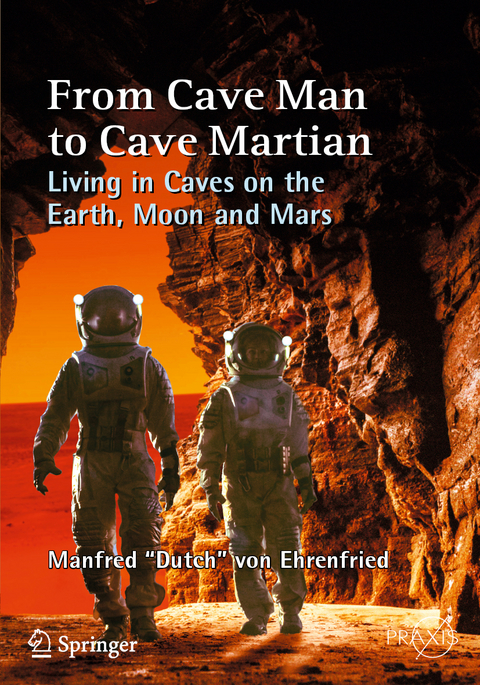
From Cave Man to Cave Martian
Springer International Publishing (Verlag)
978-3-030-05407-6 (ISBN)
Included in these pages is a short history on the uses of caves by early humans over great periods of time. It then describes the ongoing efforts to research caves, pits, tunnels, lava tubes, skylights and the associated technologies that pertain to potential lunar and Mars exploration and habitation. It describes evidence for existing caves and lava tubes on both the Moon and Mars. The work of noted scientists, technologists and roboticists are referenced and described. This ongoing work is moreextensive than one would think and is directly applicable to longer term habitation and exploration of the Moon and Mars. Emphasis is also given to the operational aspects of working and living in lunar and Martian caves and lava tubes.
Dutch Von Ehrenfried worked in the space flight, aviation and nuclear fields for about 25 years. He was a NASA Flight Controller in Mission Control for many Mercury, Gemini and Apollo Missions. He also worked on some of the Apollo Lunar Experiment Packages from an operations point of view as well as experiments that went into Skylab from an Earth Resources Program perspective. He worked in the NASA Headquarters Space Station Task Force and the Program Office as a contractor for about 10 years and the FAA Aviation Safety Office for a year. As the sensor operator on the NASA High Altitude Aircraft, Dutch worked with scientists to determine how best to obtain the data they wanted from their instruments and develop a flight plan to achieve their objectives. The sensors included infrared scanners and spectrometers, radiometers, multispectral cameras (the same used on Skylab), large format cameras and other prototype systems. These flights were from 60,000 to 70,000 feet and required the use of full pressure suits. In conjunction with this work, Dutch was an Apollo Pressure Suit test subject who included tests in the Zero G aircraft, centrifuge, and vacuum chamber as well as a lot of time on tread mills. As part of this work, he was the NASA JSC Chief of Science Requirements and Operations and worked with both scientists and engineers to describe how the Apollo Lunar Experiment Packages and other experiments should be deployed and operated by the astronauts. His work with the Nuclear Regulatory Commission was primarily related to the test and evaluation of nuclear safeguards for power plants and nuclear fuel cycle facilities.
Frontispiece.- Dedication.- Acknowledgments.- Foreword.- Author's preface.- Chapter 1: Introduction.- Chapter 2:Cave Uses on Earth From Prehistory to the Present.- Chapter 3: Lunar and Mars Caves, Lava Tubes and Pits.- Chapter 4: Terrestrial Cave and Lava Tube Research.- Chapter 5: Technologies.- Chapter 6: Considerations for Cave and Lava Tube Selection.- Chapter 7: A Proposed Mission for NASA's Design Reference Architecture.- Appendix 1: Lunar and Mars Satellites and Rovers.- Appendix 2: Analog Projects.- Appendix 3: Scientists in Cave and Lava Tube Research.- Appendix 4: Space Policy Directives.- Appendix 5: Quotes.- Appendix 6: Cave and Lava Tube Terminology.- References, Internet Links and Videos.- Glossary.- Image Links.- About the Author.- Index.
" The book is primarily a detailed, well-researched, long-range road map of technological applications necessary for humanity's future in space. ... This book will be of interest primarily to staunch enthusiasts of space exploration and those who work in the aerospace industry." (D.A. Brass, Choice, Vol. 57 (2), October, 2019)
“The book is primarily a detailed, well-researched, long-range road map of technological applications necessary for humanity’s future in space. … This book will be of interest primarily to staunch enthusiasts of space exploration and those who work in the aerospace industry.” (D.A. Brass, Choice, Vol. 57 (2), October, 2019)
| Erscheinungsdatum | 17.04.2019 |
|---|---|
| Reihe/Serie | Space Exploration | Springer Praxis Books |
| Zusatzinfo | XVIII, 320 p. 138 illus., 124 illus. in color. |
| Verlagsort | Cham |
| Sprache | englisch |
| Maße | 168 x 240 mm |
| Gewicht | 577 g |
| Themenwelt | Sachbuch/Ratgeber ► Natur / Technik ► Weltraum / Astronomie |
| Geschichte ► Teilgebiete der Geschichte ► Technikgeschichte | |
| Naturwissenschaften ► Physik / Astronomie ► Angewandte Physik | |
| Naturwissenschaften ► Physik / Astronomie ► Astronomie / Astrophysik | |
| Schlagworte | cave dwellers • extraterrestrial cave exploration • lava tube research • lunar caves • lunar colonization • lunar lava tubes • lunar satellites • lunar settlement • Mars caves • Mars colonization • Mars satellites • Mars settlement • space colonization |
| ISBN-10 | 3-030-05407-1 / 3030054071 |
| ISBN-13 | 978-3-030-05407-6 / 9783030054076 |
| Zustand | Neuware |
| Informationen gemäß Produktsicherheitsverordnung (GPSR) | |
| Haben Sie eine Frage zum Produkt? |
aus dem Bereich


